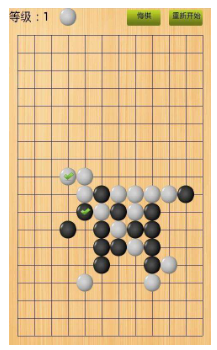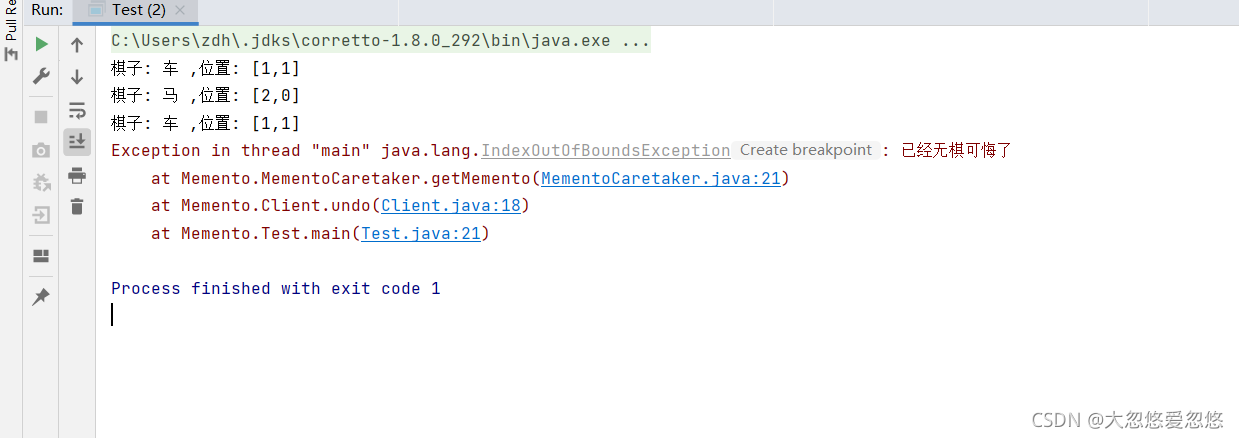引言
备忘录模式经常可以遇到,譬如下面这些场景:
- 浏览器回退:浏览器一般有浏览记录,当我们在一个网页上点击几次链接之后,可在左上角点击左箭头回退到上一次的页面,然后也可以点击右箭头重新回到当前页面
- 数据库备份与还原:一般的数据库都支持备份与还原操作,备份即将当前已有的数据或者记录保留,还原即将已经保留的数据恢复到对应的表中
- 编辑器撤销与重做:在编辑器上编辑文字,写错时可以按快捷键
Ctrl + z撤销,撤销后可以按Ctrl + y重做 - 虚拟机生成快照与恢复:虚拟机可以生成一个快照,当虚拟机发生错误时可以恢复到快照的样子
- Git版本管理:Git是最常见的版本管理软件,每提交一个新版本,实际上Git就会把它们自动串成一条时间线,每个版本都有一个版本号,使用
git reset --hard版本号 即可回到指定的版本,让代码时空穿梭回到过去某个历史时刻 - 棋牌游戏悔棋:在棋牌游戏中,有时下快了可以悔棋,回退到上一步重新下
备忘录模式(Memento Pattern)
在不破坏封装的前提下,捕获一个对象的内部状态,并在该对象之外保存这个状态,这样可以在以后将对象恢复到原先保存的状态。它是一种对象行为型模式,其别名为Token。
角色
- Originator(原发器):它是一个普通类,可以创建一个备忘录,并存储它的当前内部状态,也可以使用备忘录来恢复其内部状态,一般将需要保存内部状态的类设计为原发器,需要被数据备份的对象
- Memento(备忘录):存储原发器的内部状态,根据原发器来决定保存哪些内部状态。备忘录的设计一般可以参考原发器的设计,根据实际需要确定备忘录类中的属性。需要注意的是,除了原发器本身与负责人类之外,备忘录对象不能直接供其他类使用,原发器的设计在不同的编程语言中实现机制会有所不同。用来保存备份数据的对象
- Caretaker(负责人):负责人又称为管理者,它负责保存备忘录,但是不能对备忘录的内容进行操作或检查。在负责人类中可以存储一个或多个备忘录对象,它只负责存储对象,而不能修改对象,也无须知道对象的实现细节。备份的数据会有多份,因此需要有一个类来管理这些备份
备忘录模式的核心是备忘录类以及用于管理备忘录的负责人类的设计。
说明:如果希望保存多个originator对象的不同时间的状态,也可以,只需要 HashMap <String, 集合>
为什么会出现守护者对象(负责人)?
举个例子说明,下棋软件要提供“悔棋”功能,用户走错棋或操作失误后可恢复到前一个步骤。悔棋可能回到上一步,也有可能回到上上次的状态…因此需要记录多次的状态


在设计备忘录类时需要考虑其封装性,除了Originator类,不允许其他类来调用备忘录类Memento的构造函数与相关方法,如果不考虑封装性,允许其他类调用setState()等方法,将导致在备忘录中保存的历史状态发生改变,通过撤销操作所恢复的状态就不再是真实的历史状态,备忘录模式也就失去了本身的意义。
备忘录模式实现框架
originator : 对象(需要保存状态的对象)
public class Originator {
private String state;//状态
public String getState() {
return state;
}
public void setState(String state) {
this.state = state;
}
//编写一个方法,可以保存一个状态对象Memento
public Memento saveStateMemento(){
return new Memento(state);
}
public void getStateFromMemento (Memento memento){
state = memento.getState();
}
}
Memento : 备忘录对象,负责保存好记录,即Originator内部状态
public class Memento {
private String state;
public Memento(String state) {
this.state = state;
}
public String getState() {
return state;
}
}
Caretaker: 守护者对象,负责保存多个备忘录对象, 使用集合管理,提高效率
public class Caretaker {
//List集合中会有很多备忘录对象
private List<Memento> mementoList = new ArrayList<>();
public void add(Memento memento) {
mementoList.add(memento);
}
//获取到第index个Origintor的备忘录对象
public Memento get(int index){
return mementoList.get(index);
}
}
下棋案例
棋子类 Chessman,原发器角色
//原发器,需要保存对象的状态
@Data
@AllArgsConstructor
public class Chessman
{
private String label;//当前棋子的名字: 车,炮,马
private Integer x,y;//当前棋子的坐标
//保存当前对象的状态--备份数据
public ChessmanMemento save()
{
return new ChessmanMemento(label,x,y);
}
//恢复当前对象的状态
public void restore(ChessmanMemento chessmanMemento)
{
this.label=chessmanMemento.getLabel();
this.x=chessmanMemento.getX();
this.y=chessmanMemento.getY();
}
//展示当前对象的状态
public void show()
{
System.out.println(
String.format("棋子: %s ,位置: [%d,%d]",label,x,y)
);
}
}
备忘录角色 ChessmanMemento
//负责备份的棋子状态
@Data
@AllArgsConstructor
public class ChessmanMemento
{
private String label;
private Integer x,y;
}
负责人角色 MementoCaretaker
//负责保存多个备份对象
public class MementoCaretaker
{
//记录当前所处的备份状态
Integer index=-1;//一开始没有备份数据
//通过一个List集合保存多个备份对象
List<ChessmanMemento> chessmanMementoLinkedList= Lists.newLinkedList();
//悔棋操作--恢复到上一个备忘录状态
public ChessmanMemento getMemento()
{
if(index<=0)
{
throw new IndexOutOfBoundsException("已经无棋可悔了");
}
this.index--;//当前所处的备份状态减去一
//将当前状态之后的状态全部清空
//保留前index个元素,并将流收集到List中
chessmanMementoLinkedList = chessmanMementoLinkedList.stream()
.limit(this.index+1).collect(Collectors.toList());
return chessmanMementoLinkedList.get(index);
}
//下棋---增加新的备份对象
public void addMemento(ChessmanMemento chessmanMemento)
{
index++;
chessmanMementoLinkedList.add(chessmanMemento);
}
}
棋子客户端,维护了一个 MementoCaretaker 对象
//客户端
public class Client
{
//维护一个守护者对象
MementoCaretaker mementoCaretaker=new MementoCaretaker();
//下棋
public void play(Chessman chessman)
{
//通过调用备份返回,返回一个备份对象,添加进备份集合中去
mementoCaretaker.addMemento(chessman.save());
}
//悔棋
public void undo(Chessman chessman)
{
//得到上一次记录的备份状态对象
ChessmanMemento memento = mementoCaretaker.getMemento();
//调用恢复功能
chessman.restore(memento);
}
}
测试
public class Test
{
public static void main(String[] args) {
//创建棋子对象
Chessman chessman=new Chessman("车",1,1);
//创建一个客户端
Client client=new Client();
client.play(chessman);
chessman.show();
chessman=new Chessman("马",2,0);
client.play(chessman);
chessman.show();
//悔棋
client.undo(chessman);
chessman.show();
client.undo(chessman);
chessman.show();
}
}

备忘录模式总结
优点
- 它提供了一种状态恢复的实现机制,使得用户可以方便地回到一个特定的历史步骤,当新的状态无效或者存在问题时,可以使用暂时存储起来的备忘录将状态复原。
- 备忘录实现了对信息的封装,一个备忘录对象是一种原发器对象状态的表示,不会被其他代码所改动。备忘录保存了原发器的状态,采用列表、堆栈等集合来存储备忘录对象可以实现多次撤销操作。
缺点
- 资源消耗过大,如果需要保存的原发器类的成员变量太多,就不可避免需要占用大量的存储空间,每保存一次对象的状态都需要消耗一定的系统资源。
适用场景
- 保存一个对象在某一个时刻的全部状态或部分状态,这样以后需要时它能够恢复到先前的状态,实现撤销操作。
- 防止外界对象破坏一个对象历史状态的封装性,避免将对象历史状态的实现细节暴露给外界对象。
注意细节
- 给用户提供了一种可以恢复状态的机制,可以使用户能够比较方便地回到某个历史的状态
- 实现了信息的封装,使得用户不需要关心状态的保存细节
- 如果类的成员变量过多,势必会占用比较大的资源,而且每一次保存都会消耗一定的内存, 这个需要注意
- 适用的应用场景:1、后悔药。 2、打游戏时的存档。 3、Windows 里的 ctri + z。4、IE 中的后退。4、数据库的事务管理
- 为了节约内存,备忘录模式可以和原型模式配合使用